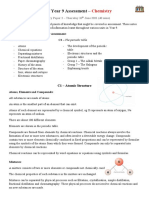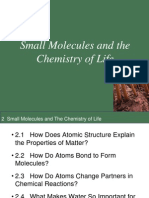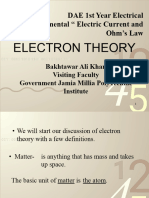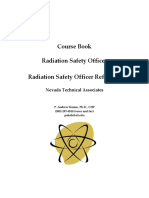Chapter 2 Lecture Slides
Uploaded by
Marie Spencer DunnChapter 2 Lecture Slides
Uploaded by
Marie Spencer Dunn1/4/2012
Chapter 2 ATOMS
Classification of Matter
Matter
Pure Substance
Physically Separable into
Mixture
Element
Compound
Homogeneous
Heterogeneous
Combine Chemically to form
Chapter 2: Atoms 1 Chapter 2: Atoms
Ch 1
Pure Substances
Element
One type of atom Represented in Periodic Table Elemental form: monoatomic, diatomic, polyatomic
Compound
Two or more types of atoms Ratio is fixed H20 vs H2O2
Chapter 2: Atoms
Chapter 2: Atoms
4 Fig. 2-5, p. 37
1/4/2012
Representations of Compounds
Diatomic Molecules- Magic 7
H2 N2 O2 F2 Cl2 Br2 I2
Chapter 2: Atoms 5 Chapter 2: Atoms 6
Mixtures
Chicken Noodle Soup Blood Sample Salt Water
Daltons Atomic Theory
An element is composed of tiny, indivisible, indestructible particles called atoms All atoms of an element are identical and have the same properties Atoms of one element cannot disappear or be changed into atoms of a different element Atoms of different elements combine to form compounds. Compounds contain atoms in constant, small whole number ratios
Heterogeneous
Heterogeneous
Homogeneous
Molecules of a compound have to have the same element in the same ratio
A molecule is a tightly bound combination of two or more atoms that act as a single unit
Ch 1
Chapter 2: Atoms 7 Chapter 2: Atoms 8
1/4/2012
Evidence for Daltons Theory
Law of Conservation of Mass- Lavoisier 17431794 Matter can be neither created or destroyed. As Dalton explained, if matter is made up of indestructible atoms, then any chemical reaction just changes the attachments among atoms, but does not destroy the atoms themselves.
Daltons Atomic Theory
An element is composed of tiny, indivisible, indestructible particles called atoms All atoms of an element are identical and have the same properties
Atoms of one element cannot disappear or be changed into atoms of a different element
Atoms of different elements combine to form compounds. Compounds contain atoms in constant, small whole number ratios
Molecules of a compound have to have the same element in the same ratio
A molecule is a tightly bound combination of two or more atoms that act as a single unit
Chapter 2: Atoms
Chapter 2: Atoms
10
Law of Constant Composition
Daltons Atomic Theory
An element is composed of tiny, indivisible, indestructible particles called atoms All atoms of an element are identical and have the same properties Atoms of one element cannot disappear or be changed into atoms of a different element
Atoms of different elements combine to form compounds. Compounds contain atoms in constant, small whole number ratios
More Evidence for Daltons Theory
(Proust 1754-1826)
Chapter 2: Atoms 11
Molecules of a compound have to have the same element in the same ratio A molecule is a tightly bound combination of two or more atoms that act as a single unit
Chapter 2: Atoms 12
1/4/2012
A Typical Atom
Figure 2.6 Relative sizes of the atomic nucleus and an atom.
Subatomic Particles
Table 2.1 Properties and Location within Atoms of Protons, Neutrons, and Electrons
Mass S ubatomic (g) Charge particle Proton Electron Neutron +1 -1 0 1.6726 x 10
-24
Mass (amu) 1.0073
Mass (amu); to one significant figure 1
Location in an atom In the nucleus Outside the ucleus In the n ucleus
If we imagine the atoms nucleus to be the size of a bean, the atom itself will become the size of a stadium, and the electrons will be like tiny fleas whizzing frantically somewhere around the stands.
9.1094 x 10-28 5.4859 x 10-4 0.0005 1.6749 x 10-24 1.0087 1
The unit of mass is the atomic mass unit (amu). One amu is defined as the mass of an atom of carbon with 6 protons and 6 neutrons in its nucleus.
1 amu = 1.6605 x 10-24 g
Chapter 2: Atoms 14
Chapter 2: Atoms
13
Subatomic Particles
Table 2.1 Properties and Location within Atoms of Protons, Neutrons, and Electrons
Mass S ubatomic (g) Charge particle Proton Electron Neutron +1 -1 0 1.6726 x 10
-24
Mass (amu) 1.0073
Mass (amu); to one significant figure 1
Location in an atom In the nucleus Outside the ucleus In the n ucleus
9.1094 x 10-28 5.4859 x 10-4 0.0005 1.6749 x 10-24 1.0087 1
THE NUCLEUS
Mass of atom is concentrated in the nucleus
Chapter 2: Atoms 15 Chapter 2: Atoms - The Nucleus 16
1/4/2012
Mass and Atomic Number
Mass number: The sum of the number of protons and neutrons in the nucleus of an atom.
The mass of the electrons in an atom is so small compared to that of its protons and neutrons that electrons are not counted in determining mass number.
Mass number (number of protons & neutrons) Atomic number (number of protons)
12 6C
Atomic number: The number of protons in the nucleus of an atom.
Mass number (number of protons & neutrons) Atomic number (number of protons)
12 6C
A carbon atom of this composition is referred to as carbon-12.
Chapter 2: Atoms - The Nucleus 17
Clarification point- Isotopic Symbol vs appearance in periodic table
Chapter 2: Atoms - The Nucleus
18
120 37 17 50
Cl Sn
Symbol Examples
Symbol
37 17
IsotopesAtoms with the same protons Same protons=same element Different # of neutrons
All atoms of an element are identical and have the same properties
Mass # (A)
Atomic # (B)
p+
n0
e-
Cl
Mercury-202 33 92 75 146 33 92
Chapter 2: Atoms - The Nucleus
19
Chapter 2: Atoms - The Nucleus
20
1/4/2012
Atomic Weight Simple vs weighted Average
Of all the shotput balls manufactured, 75% are 16 lb and 25% are 8 lb. What is the average mass of a shotput ball?
12 lbs Simple average 2 Why is this not a reasonable or fair answer? Weighted average consider a percentage as a 100 object sample size (75 16 lbs) (25 8 lbs) 14 lbs ? 100 16 lbs 8 lbs
Masses reported are a weighted average of the masses (in amu) of its isotopes found on the earth
Chapter 2: Atoms - The Nucleus 21
Chapter 2: Atoms - The Nucleus
22
Relative abundance
Two common isotopes of carbon
12C
Atomic Weight
Calculate the atomic weight of silicon given that:
Isotope
28Si
carbon-12 (12.000 amu) and 13C carbon-13 (13.003 amu)
Mass 27.977 amu 28.976 amu 29.974 amu Abundance 92.21% 4.70% 3.09% Contribution to mass
(0.922127.977amu) (0.047028.976amu) (0.299743.09amu)
=25.79759 amu =1.36 187 amu =0.92620 amu
What can you say about the relative abundance of the two isotopes?
29Si 30Si
=28.09 amu Check answer with P.T
Chapter 2: Atoms - The Nucleus 23 Chapter 2: Atoms - The Nucleus 24
1/4/2012
Modern Periodic Table Dmitri Mendeleev (1860)s
Elements in order of increasing atomic weight
Modern table is by atomic #
Modern Periodic Table Dmitri Mendeleev (1860)s
Elements in order of increasing atomic weight
Modern table is by atomic #
1 2 3 4 5 6 7 6 7
A new period (row) was started when properties recurred
Chapter 2: Atoms
25
Chapter 2: Atoms
26
Noble Gas
Halogens
Alkaline Earth Metals
Modern Periodic Table Dmitri Mendeleev (1860)s
Elements in order of increasing atomic weight
Modern table is by atomic #
Alkali Metals
Modern Periodic Table Dmitri Mendeleev (1860)s
Elements in order of increasing atomic weight
Modern table is by atomic #
A new period (row) was started when properties recurred (Numbered 1-7) Elements with similar properties are in the same group or family (columns 1A-8A) Alkali Metals Alkaline Earth Metals Halogens Noble Gases Blocks of elements in Groups 1A -8A are known as maingroup elements
A new period (row) was started when properties recurred (Numbered 1-7) Elements with similar properties are in the same group or family (columns 1A-8A) Alkali Metals Alkaline Earth Metals Halogens Noble Gases Blocks of elements in Groups 1A -8A are known as maingroup elements Transition elements Inner-transition elements
Chapter 2: Atoms
27
Chapter 2: Atoms
28
1/4/2012
Classification of the Elements
Classification of the Elements
Chapter 2: Atoms
29
Chapter 2: Atoms
30
Classification of the Elements
Metals Nonmetals
Are solids at room temperature (except for Hg, which is a liquid), shiny, conduct electricity, and are ductile and malleable. Form alloys (solutions of one metal dissolved in another); brass, for example, is an alloy of copper and zinc. In chemical reactions, they tend to give up electrons. Most elements are metals! Except for hydrogen (H), they lie on the right side of the Periodic Table. Can be solid, liquid, or gas at room temperature Except for graphite, do not conduct electricity. In chemical reactions, they tend to accept electrons. Only 18!
Classification of the Elements
Metalloids
Only 6!
Chapter 2: Atoms
31
Chapter 2: Atoms
32
1/4/2012
Periodicity
Use trends to make predictions
Periodicity- Chemistry of elements in the same family is similar
C combines with O to form the compound CO2 What is the formula for the compound formed from Si and O?
Caution!
GIVEN:
Formulas of metal oxides Na2O MgO Al2O3
PREDICT:
Formulas of other oxides and sulfides
Chapter 2: Atoms
33
Chapter 2: Atoms
34
Animation: Electrons Orbiting Nucleus vs. Electron Cloud
SPACE OCCUPIED BY ELECTRONS
Chapter 2: Atoms - The Nucleus 35 Chapter 2: Atoms 36
1/4/2012
How are electrons arranged in an atom?
Energy Level Sublevel Orbital
Chapter 2: Atoms
How are Electrons in an Atom Arranged?
The Rules: Fill from lowest energy to highest Only two electrons per orbital Only pair up electrons in the same orbital IF there are no other equal energy orbitals available. (Electrons REPELL each other!)
# 1 2 3 4 5 6 7 8
Sy
Orbital Box Diagram
Electron Configuration
Noble Gas Notation
Lewis Dot Structure
Floor Hall Room
37
Keep track of..
10 11 12 13 14 15 16
Chapter 2: Atoms
17 18
38
How are Electrons in an Atom Arranged?
The Rules: Fill from lowest energy to highest Only two electrons per orbital Only pair up electrons in the same orbital IF there are no other equal energy orbitals available. (Electrons REPELL each other!)
How are Electrons in an Atom Arranged?
The Rules: Fill from lowest energy to highest Only two electrons per orbital Only pair up electrons in the same orbital IF there are no other equal energy orbitals available. (Electrons REPELL each other!)
3d 4 3 3s 2 2s 2p 3p
4 3
Energy
Once upon a time..
2 2s
2p
Once upon a time..
Energy
1s
39
1s
40
Chapter 2: Atoms
Chapter 2: Atoms
10
1/4/2012
4f
How are Electrons in an Atom Arranged?
The Rules: Fill from lowest energy to highest Only two electrons per orbital Only pair up electrons in the same orbital IF there are no other equal energy orbitals available. (Electrons REPELL each other!)
The Blueprint!
You are responsible for first 3 periods
4d
Energy
4p 3d 4 4s 3 3s 3p
Once upon a time..
This is getting complicated!
2 2s
2p
Chapter 2: Atoms
41
Chapter 2: Atoms
42
Use the Blueprint
Symbol Li Na C Si Ne Ar # electrons 3 11 6 14 10 18 Orbital Sublevel (s) Dot Picture Electron configuration
Lets look at the 2nd energy level
Energy Level
Sublevel (p)
Orbital
Orbital
Orbital
Li Na
C Si
Ne Ar
Chapter 2: Atoms
43
How many electrons occupy the 2nd energy level? How many electrons occupy the 2p sublevel? How many electrons occupy a 2p orbital?
Chapter 2: Atoms
44
11
1/4/2012
Energy Level
Lets look at the 3rd energy level
What are orbitals?
Regions of probability Specific shapes and orientations
Sublevel (s)
Sublevel (p)
Sublevel (d)
Orbital
Orbital
Orbital
Orbital
Orbital
orbital
orbital
orbital
orbital
1s
2s
2px
2py
2pz
How many electrons occupy the 3rd energy level? How many electrons occupy the 3p sublevel? How many electrons occupy a 3d orbital?
Chapter 2: Atoms
45
Chapter 2: Atoms
46
Topics Not Covered
Periodic Properties Ionization Energy Size of an atom
Chapter 2: Atoms
47
12
You might also like
- A Detailed Lesson Plan in Periodic Table of Elements97% (31)A Detailed Lesson Plan in Periodic Table of Elements6 pages
- CHEMISTRY - Science Notes For End of Year 9 Assessment50% (2)CHEMISTRY - Science Notes For End of Year 9 Assessment7 pages
- Dr. Peter Alfred: Cambridge Igcse ChemistryNo ratings yetDr. Peter Alfred: Cambridge Igcse Chemistry186 pages
- CE 0115 - 02 - Basic Concepts and Calculations in ChemistryNo ratings yetCE 0115 - 02 - Basic Concepts and Calculations in Chemistry133 pages
- Atoms: Click To Edit Master Subtitle StyleNo ratings yetAtoms: Click To Edit Master Subtitle Style28 pages
- Lesson 1 Notes - (GCSE Edexcel Chemistry)No ratings yetLesson 1 Notes - (GCSE Edexcel Chemistry)7 pages
- Chapter 3 - Atomic Structure and Periodic Table - EDX.No ratings yetChapter 3 - Atomic Structure and Periodic Table - EDX.6 pages
- Atoms: Frederick A. Bettelheim William H. Brown Mary K. Campbell Shawn O. FarrellNo ratings yetAtoms: Frederick A. Bettelheim William H. Brown Mary K. Campbell Shawn O. Farrell45 pages
- Chapter 2 (Atomic Structure and Atomic Bonding)No ratings yetChapter 2 (Atomic Structure and Atomic Bonding)26 pages
- 3.CLASSIFICATION OF ELEMENTS AND PERIODICITY IN PROPERTIESNo ratings yet3.CLASSIFICATION OF ELEMENTS AND PERIODICITY IN PROPERTIES32 pages
- Copy-of-Genchem-G1_20241105_135222_0000 (1)No ratings yetCopy-of-Genchem-G1_20241105_135222_0000 (1)77 pages
- CHEM 110 - First Term - 2024 - 2025 - Chapter 2No ratings yetCHEM 110 - First Term - 2024 - 2025 - Chapter 241 pages
- Notes - Periodic Classification of Elements - C-XNo ratings yetNotes - Periodic Classification of Elements - C-X4 pages
- Untitled Document 2024 04 29T154553.607No ratings yetUntitled Document 2024 04 29T154553.60710 pages
- General and Inorganic Chemistry For Pharmacy PDFNo ratings yetGeneral and Inorganic Chemistry For Pharmacy PDF91 pages
- AOS1: The Periodic Table: Atomic Theory RevisionNo ratings yetAOS1: The Periodic Table: Atomic Theory Revision6 pages
- MT633 - Unit 1 Chemical Foundations ForNo ratings yetMT633 - Unit 1 Chemical Foundations For109 pages
- Week 1-Atoms and The Periodic Table. DistributionNo ratings yetWeek 1-Atoms and The Periodic Table. Distribution41 pages
- 6 - Copper - Silver and Magnesium ReactionsNo ratings yet6 - Copper - Silver and Magnesium Reactions12 pages
- Electron Theory DAE 1st Year ElectricalNo ratings yetElectron Theory DAE 1st Year Electrical21 pages
- Energy Production in Stars - HansBethe1939 PDFNo ratings yetEnergy Production in Stars - HansBethe1939 PDF23 pages
- UNIBEN Physical Science and Engineering Page 1-69No ratings yetUNIBEN Physical Science and Engineering Page 1-6970 pages
- Cambridge International AS & A Level: Physics 9702/21No ratings yetCambridge International AS & A Level: Physics 9702/2116 pages
- Smart Test Series: Q.1 Four Possible Answers A, B, C & D To Each Question Are Given. Circle The Correct One. (20x1 20)No ratings yetSmart Test Series: Q.1 Four Possible Answers A, B, C & D To Each Question Are Given. Circle The Correct One. (20x1 20)23 pages
- (Facts On File Science Library) Spangenburg, Ray - Moser, Diane - Spangenburg, Ray-Science Frontiers, 1946 To The Present-Facts On File (2004)100% (2)(Facts On File Science Library) Spangenburg, Ray - Moser, Diane - Spangenburg, Ray-Science Frontiers, 1946 To The Present-Facts On File (2004)273 pages
- Introduction To Computational ChemistryNo ratings yetIntroduction To Computational Chemistry14 pages
- A Detailed Lesson Plan in Periodic Table of ElementsA Detailed Lesson Plan in Periodic Table of Elements
- CHEMISTRY - Science Notes For End of Year 9 AssessmentCHEMISTRY - Science Notes For End of Year 9 Assessment
- CE 0115 - 02 - Basic Concepts and Calculations in ChemistryCE 0115 - 02 - Basic Concepts and Calculations in Chemistry
- Chapter 3 - Atomic Structure and Periodic Table - EDX.Chapter 3 - Atomic Structure and Periodic Table - EDX.
- Atoms: Frederick A. Bettelheim William H. Brown Mary K. Campbell Shawn O. FarrellAtoms: Frederick A. Bettelheim William H. Brown Mary K. Campbell Shawn O. Farrell
- 3.CLASSIFICATION OF ELEMENTS AND PERIODICITY IN PROPERTIES3.CLASSIFICATION OF ELEMENTS AND PERIODICITY IN PROPERTIES
- GCSE Chemistry Revision: Cheeky Revision ShortcutsFrom EverandGCSE Chemistry Revision: Cheeky Revision Shortcuts
- Cambridge International AS & A Level: Physics 9702/21Cambridge International AS & A Level: Physics 9702/21
- Smart Test Series: Q.1 Four Possible Answers A, B, C & D To Each Question Are Given. Circle The Correct One. (20x1 20)Smart Test Series: Q.1 Four Possible Answers A, B, C & D To Each Question Are Given. Circle The Correct One. (20x1 20)
- (Facts On File Science Library) Spangenburg, Ray - Moser, Diane - Spangenburg, Ray-Science Frontiers, 1946 To The Present-Facts On File (2004)(Facts On File Science Library) Spangenburg, Ray - Moser, Diane - Spangenburg, Ray-Science Frontiers, 1946 To The Present-Facts On File (2004)

































































































